Game deer species
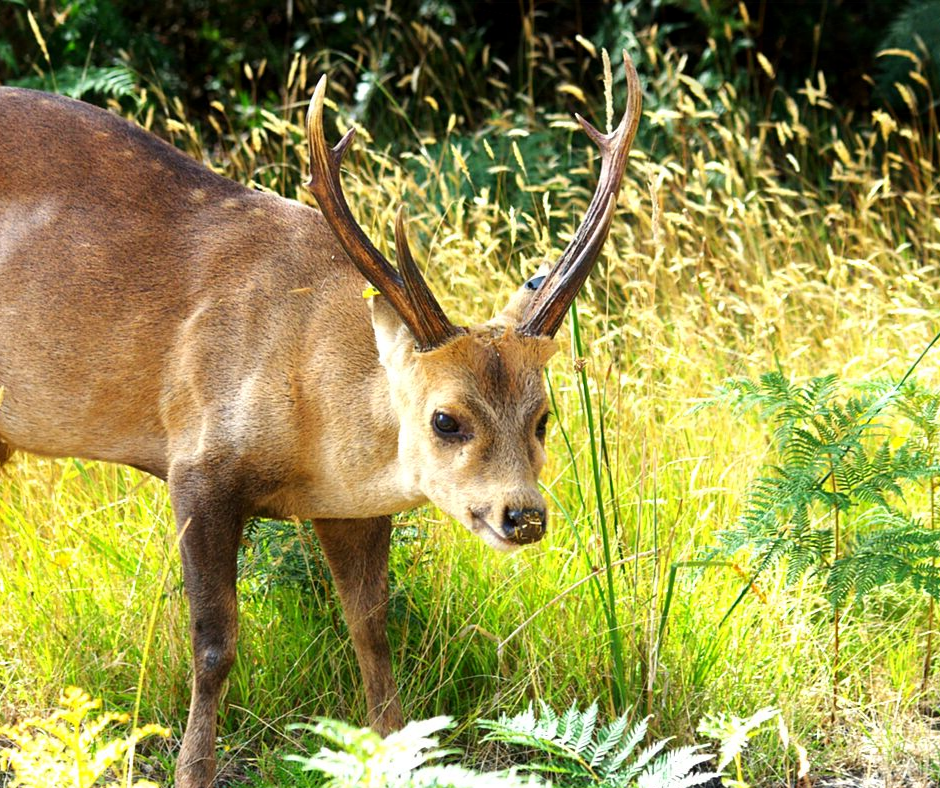 Deer hunting is a popular activity in Victoria. Deer introduced by acclimatisation societies have been recorded in the wild in Victoria since at least the 1860's.
Deer hunting is a popular activity in Victoria. Deer introduced by acclimatisation societies have been recorded in the wild in Victoria since at least the 1860's.
Today Victoria has a large deer population, predominantly made up of Sambar, Fallow and Red Deer.
Most deer hunting occurs in the east of the state which reflects the main distribution of deer in Victoria.
The large populations of deer in Victoria means that, except for Hog Deer, there is no bag limit for deer. There is also no closed season for deer, except for Hog Deer and Sambar Deer hunting with hounds.
Status of deer
In Victoria, all deer are declared to be 'wildlife' for the purposes of the Wildlife Act 1975 (the Act). 'Wildlife' are further considered to be 'protected wildlife' and may not be destroyed without authorisation, except where they are listed under the Catchment and Land Protection Act 1994 (CALP Act) or where they are declared to be 'unprotected' under the Act. Six deer species are listed as game for the purpose of hunting. These include the most established and widespread deer in Victoria. Deer are appreciated for their aesthetics and are a valued hunting resource.
(Hog Deer photo from Parapark)
Sambar Deer (Cervus unicolor)
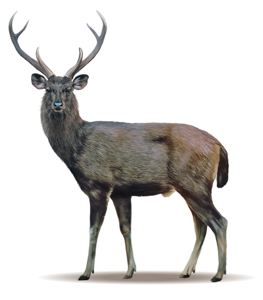
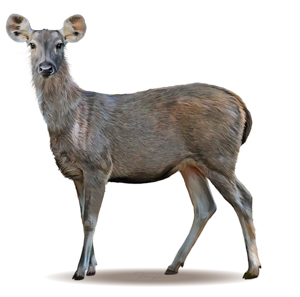
Sambar Deer (stag) Sambar Deer (hind)
Introduction and distribution
Sambar Deer were introduced to Australia from India, Ceylon and Malaysia in the 1860s.
Sambar Deer are hunted either by stalking or with the use of hounds, gundogs or deer hunting dogs. Different rules and regulations apply to these methods and hunters must ensure that they understand and adhere to them.
Appearance
Sambar Deer are a very large deer. A mature stag can stand 130cm at the shoulder and weigh up to 230kg. The hinds are smaller in size and stand up to 110cm and weigh up to 180kg. They are uniform dark brown with ginger and cream under-parts. The hair is very stiff and coarse. The antlers are have typically three points on each side (six-tined), are heavy and may reach lengths of greater than 30 inches.
Habitat and herding
Sambar Deer are solitary by nature, extremely wary and inhabit difficult and complex terrain. They frequent many different habitat types from heavy forest, rough mountainous terrain to more open-country.
Victoria has a very healthy population of Sambar Deer and are one of the most difficult species to hunt. There are exceptional hunting opportunities in eastern and central Victoria. Populations also exist in New South Wales and the Northern Territory.
Hog Deer (Axis porcinus)
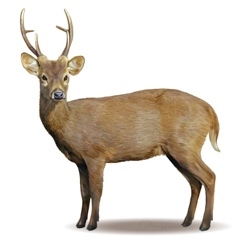
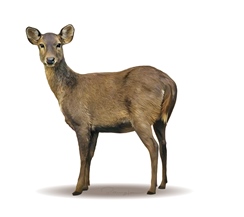
Hog Deer (stag) Hog Deer (hind)
Introduction and distribution
Hog Deer were introduced to Australia from India and Ceylon in the 1860's. Hog Deer populations occur throughout the Gippsland coastal area in low to moderate concentrations. Victoria offers the only viable hunting opportunity for this species in Australia.
Appearance
Hog Deer have a brownish/straw colour coat and may have white spots in the summer. The underside is white/cream. The Hog Deer is the smallest deer species in Australia. A mature stag stands around 70cm at the shoulder and weighs about 50kg. The hind is somewhat smaller, weighing only 30kg. The antlers typically have three points on each side (six-tined), are thin and may grow to around 16 inches.
Habitat and herding
The Hog Deer is a herding animal and is found in the coastal tea-tree swamp areas. They prefer to graze at dawn and dusk. Hog Deer do not cast their antlers in a regular fashion, however, around August to October is most common. There are a number of rules and regulations that all Hog Deer hunters must be aware of before they go hunting. All hunters must obtain tags before hunting Hog Deer. Open season: from the first day in April (1 April) to last day in April (30 April) each year. Bag limit: one (1) male (stag) and one (1) female (hind) may be taken during the open season.
Red Deer (Cervus elaphus)
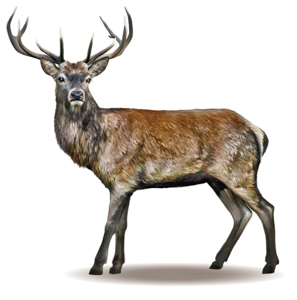
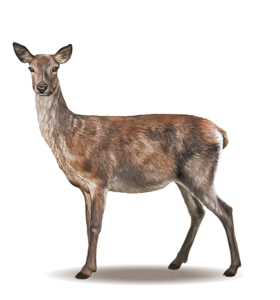
Red Deer (stag) Red Deer (hind)
Introduced
Red Deer were introduced to Australia from England in 1860.
Appearance
Adult Red Deer typically have a reddish-brown coat. Calves are spotted at birth.
They are a medium to large-sized deer. Mature stags will stand around 120cm at the shoulder and weigh approximately 160kg. Hinds are approximately two-thirds the size of the male.
Red Deer antlers can grow as long as 40 inches and have 14 points individually, however, antlers around 25 inches with eight points is the norm. A good trophy stag has multiple tines and a majestic shape.
Habitat and distribution
Red Deer are a herd animal and have a strong herding instinct and highly developed social order. The rut occurs around April and the stags are quite vocal. Stags roar to attract receptive females and will fight to protect their harems from rivals.
Red Deer are adaptable to different habitat types, although they are seen predominately in mountainous forested terrain they are equally at home in choked gullies. They are a browsing animal that will also graze on pasture; for this reason they prefer areas of open forest.
Red Deer occur in Victoria, New South Wales and Queensland. Red Deer have some well-established populations and provide reasonable hunting opportunities in Victoria. Most Red Deer hunting occurs on private land where permission must be sought from the landowner.
Fallow Deer (Dama dama)
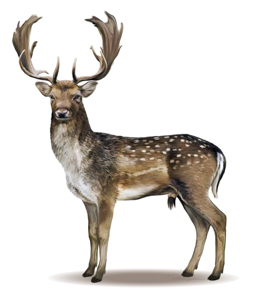
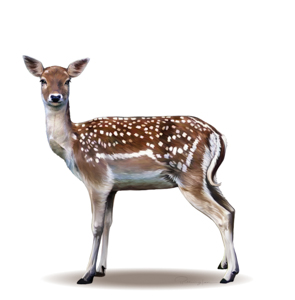
Fallow Deer (buck) Fallow Deer (Doe)
Introduction and distribution
Fallow Deer were introduced to Australia from England in the 1830's. Fallow are now found in all states with the exception of the Northern Territory. Their strongest foot-holds are Tasmania, South Australia and New South Wales. However, Victoria now has extensive populations of Fallow that offer good hunting opportunities.
Appearance
The Fallow is a very pretty deer of medium size. A mature buck will stand up-to about 95 cm at the shoulder and weigh up to about 90kg. The hinds will be half the size of a stag standing up-to 80cm and weighing in at about 40kgs. There are four different colour variations: red, black, white and menil (meaning spotted). The stags' antlers are quite different from any other wild Australian deer and are palmated (similar to the moose) with a reasonable representative trophy being around the 20 inch mark with 12 or more points.
Habitat and herding
The Fallow Deer are a herd deer inhabiting semi-open scrubland and frequent and graze on pasture that is in close proximity to cover. They breed during the April/May rut, fawns are born in December and the bucks cast their antlers in October. In rut, the buck makes an unmistakable croak, similar to a grunting pig which makes them an easy target for hunters.
Chital Deer (Axis axis)
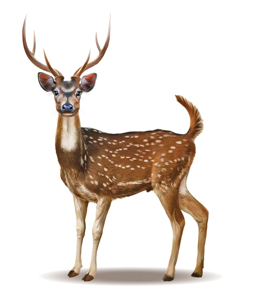
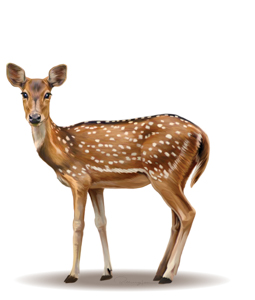
Chital Deer (stag) Chital Deer (hind)
Introduction and distribution
Chital Deer were introduced to Australia from India in the 1860s. Healthy wild populations of Chital exist in Queensland near Charters Towers, with other smaller isolated population in NSW, South Australia and Victoria. There is limited hunting opportunity for this species in Victoria.
Appearance
Chital are arguably the prettiest deer in Australia. They have a dark chocolate brown coat with extensive small white spots spread over their body.
They are a medium size deer. A mature stag will stand up to about 90cm at the shoulder and weigh about 85kg. The hind will stand up to about 80cm, weighing up to about 60kg. The antlers are typically three points on each side (six tined) and are thin and slender growing up to about 35 inches.
Habitat and herding
Chital prefer to be in a herd and inhabit the warmer inland areas of Australia, preferring swampy areas that are well grassed with a good canopy of thick cover.
Rusa Deer (Cervus timorensis)
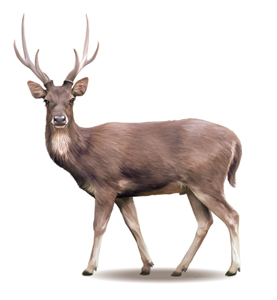
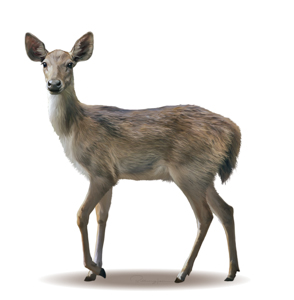
Rusa Deer (stag) Rusa Deer (hind)
Introduction and distribution
Rusa Deer were introduced to Australia from Malaysia in 1868. Rusa are found in New South Wales, Queensland and South Australia. Only isolated populations of Rusa are found in Victoria and only limited hunting opportunities exist.
Appearance
There are a number of Rusa species and they are similar to the Sambar and are able to inter-breed. The Rusa is a uniform greyish/brown and has light creamy under-parts.
They are a medium to large-sized deer. A mature stag will stand up to 110cm at the shoulder and weigh around 135kg. The hind is about two-thirds the size of the stag.
The stags' antlers are typically three points on each side (six-tined) and the inner tops are generally parallel. They are known to grow antlers to the 36 inch mark.
Habitat and herding
Rusa inhabit numerous different habitat types, from farm fringe to thickly vegetated swampy areas. Rusa Deer form small herds.
Page last updated: 22 Jun 2023